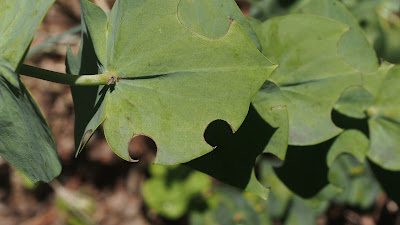summertime, and the living is easy
Who munched the leaves of some Derwentia perfoliata plants, leaving smooth semi-circular holes at the edge? It was a native bee, a friendly pollinator. Solitary female Leafcutter Bees remove these discs from the leaves so they can use them for building their nests. The leaves are shaped into plugs that are filled with pollen and nectar for their offspring, then closed with a lid consisting of a neat circular piece of leaf.
 |
| Leafcutter Bee Megachile sp. Photographer Bruce Hulbert |
So I look at the garden. I look at plants that love the heat, like Catmint. I look at plants that curl up to protect themselves but unfurl when the sun sets, like Lambs Ears. I look at plants that look uncomfortable but I know from years of experience won't be summer casualties, like orange Wallflowers. (The mauve ones are much more resilient for some reason).
And ... I look at, and for, insects, spiders and birds, and any signs of them.
The leaves of the Banksia Roses got infected with sooty mould. I didn't get round to removing the diseased leaves. Then I noticed some tiny black and yellow beetles on the leaves. Identified as Fungus-eating Ladybird beetles (Illeis galbula) - these cute critters eat fungus and mould! They are welcome. Leaving the sooty mould led to an increase in the biodiversity in the garden ecosystem.



Oh, the lazy, wonderful days of summer that seem like they'll never end. You've some fascinating bugs to observe.
ReplyDeleteLast night we had a combo of snow, sleet, and freezing rain. Winter. Bleh! Yet, I know daffodils, tulips, and other pretties are slumbing underneath the frozen ground waiting for Spring. Our summers in the Pocono Mtns. of Pennsylvania are rather short, but so worth the wait! Happy gardening, Sue.
ReplyDeleteInsects are so fascinating, and your images are stunning! Good for you for allowing nature to take its course. Last winter I had quite a few lady beetles in the house, which I promptly placed on my lemon tree in the sunroom. They helped to keep the scab, whiteflies, and aphids at bay. I haven't seen many lady beetles this year, which means I will have to treat the lemon tree with organic neem oil/detergent. Enjoy your warm summer days. :)
ReplyDeleteVery interesting! That leafcutter bee is so fuzzy-looking!
ReplyDeleteMy lamb's ears are finding summer trying. They haven't read the surviving summer memo.
ReplyDeleteLovely to know that you are enjoying your summer heat as we get colder and colder! We too have leaf cutter bees and I can spend many a happy hour watching them cutting circles in my rose leaves!
ReplyDeleteOver here it is winter. Also time for watching the garden. The ladybird beetles are hiding amongst the leaflitter. I think our ladybird beetles only eat aphids. Do fungus eating ladybird beetles only live in Australia?
ReplyDelete